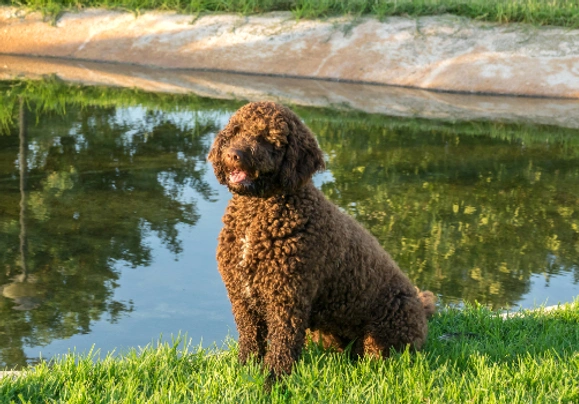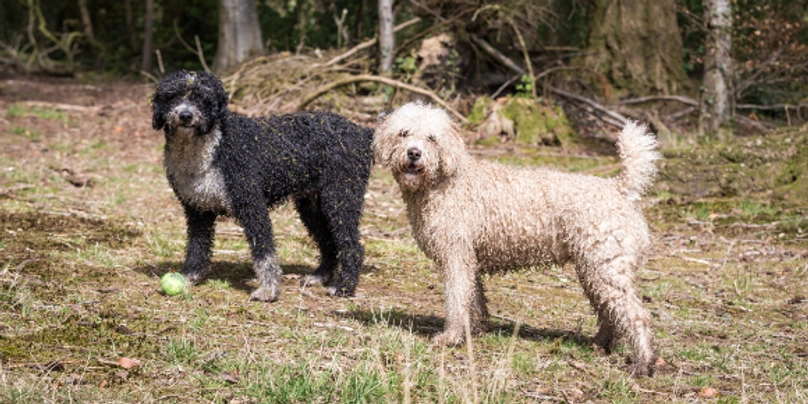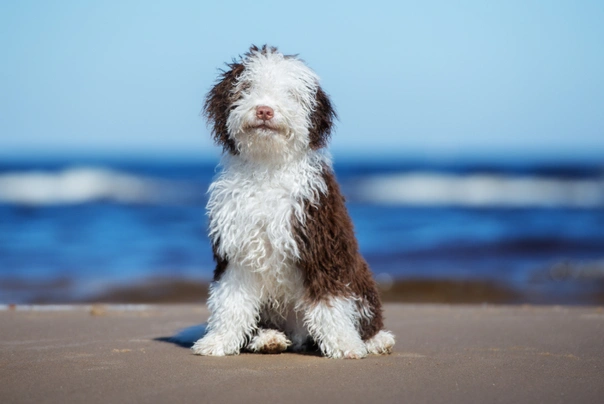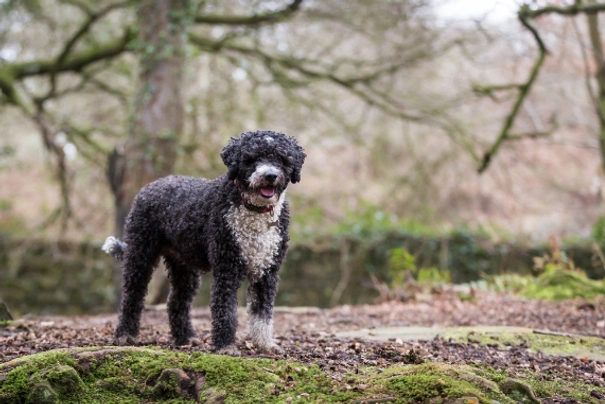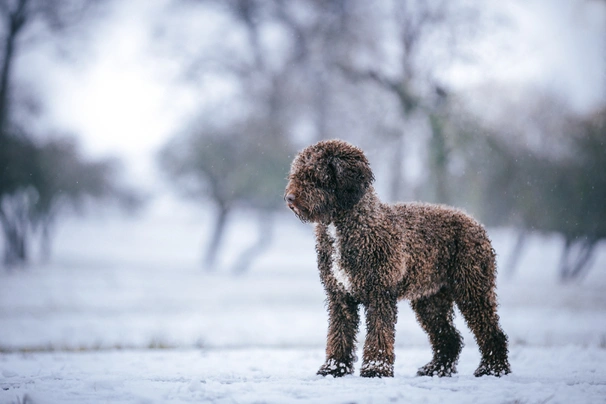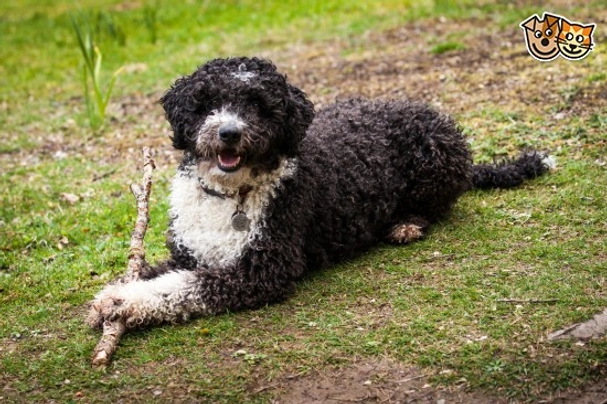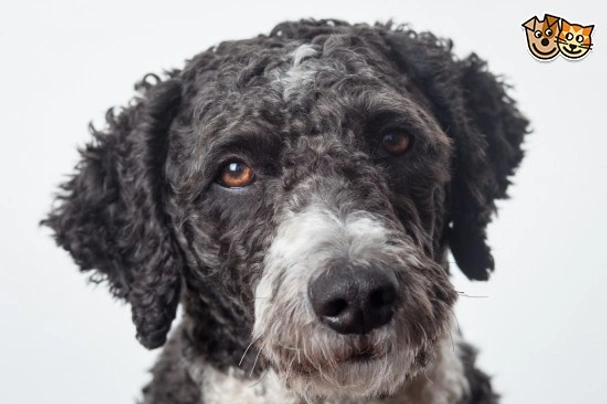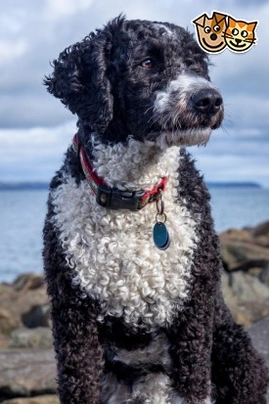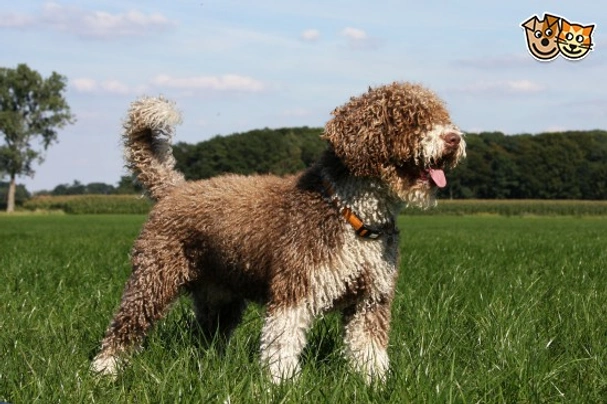Spanish Water Dog
Pros
Cons
Introduction of the Spanish Water Dog
The Spanish Water Dog is one of the lesser known breeds here in the UK although their numbers are slowly rising with more pedigree puppies being bred and registered with The Kennel Club every year. The SWD is a medium sized dog that boasts having a distinct and attractive corded coat that covers their entire body. They are intelligent dogs with a tremendous amount of stamina which is one of the reasons they have always been so highly prized for their sporting abilities. However the Spanish Water Dog is just as happy in the home environment and thrives on being part of family which makes them a great choice as a family pet thanks to their kind and loyal natures.
History of the Spanish Water Dog
The actual origins of the Spanish Water Dog are a bit of a mystery but they are believed to be one of the oldest breeds on the planet with some people believing the breed could have existed as far back as the Middle Ages or even to Roman times. These handsome dogs were first bred to herd sheep in their native Spain but they proved themselves to be extremely good at retrieving game on water and land too which soon led to them being highly prized in their native Spain.
It is thought the breed was created using the Poodle as one of its founding breeds and that the Portuguese Water Dog may even be related to the SWD and they may well share the same ancestry. In the Andalusian region of Southern Spain the Spanish Water Dog was often referred to as the ‘Andalusian Turk’ as they were thought to have descended from animals brought to the country on boats from Turkey although experts are keen to point out that there were colonies of SWDs in Spain before Turkish traders arrived in Spain.
It was not until 1975 that breed enthusiasts travelled through southern Spain in search of examples of the breed with an end goal being to establish a breeding programme. Their endeavours led to the creation of the Spanish Water Dog we see today. In 1985 the breed was officially recognised by the Spanish Kennel Club although it wasn’t permanently recognised by the Fédération Cynologique Internationale for another 14 years. The breed did not arrive on British shores until 1992 and were recognised by The Kennel Club with more examples of the SWD being exhibited at dog shows today than ever before.
However the Spanish Water Dog remains relatively unknown here in the UK with very few puppies being bred and registered with The Kennel Club every year although their numbers are slowly rising. As such anyone wishing to share a home with a SWD would need to register their interest with reputable breeders and go on a waiting list.
Interesting facts about the breed
- Is the Spanish Water Dog a vulnerable breed? No although anyone wanting to share a home with a SWD would need to register their interest with breeders and then go on a waiting list for the pleasure of doing so because not many well-bred puppies are registered with the Kennel Club every year
- They were originally bred as herding dogs but proved to be exceptionally good at retrieving game from water
- Spanish Water Dogs have a real affinity with water and children
- SWDs are exceptionally good at all sorts of watersports
Appearance of the Spanish Water Dog
Height at the withers: Males 44 - 50 cm Females 40 - 46 cm
Average weight: Males 18 - 22 kg Females 14 - 18 kg
The Spanish Water Dog is a charming looking medium sized dog that boasts a wonderfully corded coat. They have very elegant heads with just a slight hint of a stop. Their skulls are rather flat between the ears and dogs don't have a very prominent occiput. They have wide open nostrils with the corners of their lips being well defined. Their eyes are a nice oval shape and medium in size with dogs having a very kind and expressive look in them. They are set well apart and slightly obliquely on a dog's face and can be either a nice hazel or dark brown colour depending on the colour of a dog's coat.
Their ears are V-shaped being slightly rounded at the tips medium in size and set just above the level of a dog's eyes. They drop down which dogs hold slightly forward when alert or excited. The Spanish Water Dog has a strong jaw with a perfect scissor bite where their upper teeth neatly overlap their lower ones. Their necks are quite short but muscular with no dewlap and set nicely into a dog's shoulders. Front legs are well muscled straight and strong without showing too much bone.
The SWD has a compact body and a nice level backs that’s slightly higher at the wither. Chests are deep and ribs well sprung with briskets reaching down to a dog's elbows. Hindquarters are powerful with dogs having strong back legs with well-muscled first and second thighs. Feet are tight and round with strong paw pads and toe nails that match the colour of a dog's coat. Tails are medium set and taper to the tip. Dogs carry their tails low in the shape of a scimitar when at rest but raised when excited or alert.
When it comes to their coat the Spanish Water Dog boasts a striking corded coat which has a very wool-like texture. The accepted breed colours for Kennel Club registration are as follows:
- Black
- Black & Tan
- Black & White
- Black with White Markings
- Brown
- Brown & Tan
- Brown & White
- Brown with White Markings
- Cream
- Cream & White
- Cream with White Markings
- Gold & White
- Gold with White Markings
- Tricolour
- White
- White & Black
- White & Brown
- White & Cream
- White & Gold
Gait/movement
When a Spanish Water Dog moves they do so with great purpose showing a brisk and athletic gait when they do with lots of power coming from their hindquarters.
Faults
The Kennel Club frowns on any exaggerations or departures from the breed standard and would judge the faults on how much they affect a dog's overall health and wellbeing as well as their ability to perform.
Males should have both testicles fully descended into their scrotums and it is worth noting that a dog can be a little lighter or heavier as well as slightly taller or shorter than set out in the Kennel Club breed standard which is only given as a guideline.
Temperament of the Spanish Water Dog
The Spanish Water Dog boasts having a tremendous sense of smell sight and sound. As such they are true working dogs that enjoy nothing more than being out and about in the great outdoors. They are intelligent and sensitive by nature being just at ease in a home environment as they are working in the field. They form strong bonds with their owners and families and are known to be even-tempered dogs which is just one of the reasons they make such great family pets.
They are also known to have a very enthusiastic personality which sees these dogs being ultra-willing and eager to please. However puppies must be well socialised from a young enough age for them to mature into well-rounded obedient adult dogs. They are a great choice for families where the children are slightly older and who therefore know how to behave around dogs. Spanish Water Dogs tend to be a little aloof and wary of people they don't already know but rarely would one of these dogs ever show any sort of aggressive behaviour towards a stranger preferring to keep their distance until they get to know someone.
They are not the best choice for first time owners because a Spanish Water Dog needs to be handled and trained by someone who is familiar with this type of sporting dog and their specific needs. However in the right hands these striking dogs can be trained to be obedient dogs with particular attention being paid to the "recall" command. They are never happier than when they know their place in the pack and who they can look to for direction and guidance. They also need to know what an owner expects of them which in short means their training must be consistent and always fair right from the start and then throughout a dog’s life.
As their name suggests SWDs love being in water and are naturally strong swimmers which means care should be taken when walking them anywhere near more dangerous water courses just in case they decide to jump in.
Are they a good choice for first time owners?
Spanish Water Dogs are a good choice for first time dog owners providing they have the time to dedicate to an intelligent active dog and one that enjoys being out and about as often as possible. They are renowned for being great around children of all ages which is why they are such a good family pet.
What about prey drive?
Spanish Water Dogs are very social by nature and even though they have working and hunting dogs in their lineage they do not have a very high prey drive. However this is not to say that a dog would not give chase to a smaller animal when the mood takes them and this includes squirrels and the cat from next door.
What about playfulness?
SWDs have a very playful side to their natures and enjoy playing lots of interactive games more especially activities that involve retrieving things which brings out their natural talents. They adore being in water and taking part in all sorts of watersports which they are especially good at.
What about adaptability?
Spanish Water Dogs are better suited to people who live in the country or who have secure back gardens they can safely run around in whenever possible. As such they are not the best choice for anyone who lives in an apartment.
What about separation anxiety?
Although Spanish Water Dogs form strong ties with their families they do not generally suffer from separation anxiety when they are left on their own providing it is never for too long that is. No dog likes to be left to their own devices for too long and it could lead to them developing behavioural issues which includes being destructive around the home which is often their way of keeping themselves entertained.
What about excessive barking?
Spanish Water Dogs are not known to be "barkers" although they will voice an opinion when needed bearing in mind that although they were originally bred to herd livestock they proved extremely skilled at retrieving game from marshlands and water which they did efficiently and quietly only letting their handlers know when they found a bird.
Do Spanish Water Dogs like water?
All SWDs as their name suggests love swimming and will take to the water whatever the weather is doing. However if anyone who owns a dog that does not like water should never force them to go in because it would just end up scaring them. With this said care should always be taken when walking a Spanish Water Dog off the lead anywhere near more dangerous watercourses just in case a dog decides to leap in and then needs rescuing because they cannot get out of the water on their own.
Are Spanish Water Dogs good watchdogs?
SWDs are not natural watchdogs although this is not to say a dog would not be quick off the mark to let an owner know when there are strangers about although they would rarely do this aggressively preferring to keep their distance and bark to let an owner know they are upset about something.
Intelligence / Trainability of the Spanish Water Dog
The Spanish Water Dog is an intelligent character but they do have a bit of a "wandering off" streak in them which is why it's so important to teach these dogs a strong "recall" command from a very young age. With this said socialising them from a young enough age is extra important and their training also must start too. It's best to teach a SWD the basics when they are still puppies and to start their training in earnest as soon as they have been fully vaccinated and slightly older.
Being sensitive dogs by nature a Spanish Water Dog does not respond well to any sort of harsh correction or heavy-handed training methods. The key to successfully training them is to use positive reinforcement and to make a training session as interesting as possible. It’s best to keep things nice and short without too much repetition which helps keep a Spanish Water Dog more focused on what is being asked of them which as a result achieves the best results.
Spanish Water Dog puppies like all other puppies are incredibly cute and it is all too easy to spoil them when they first arrive in their new homes. However owners must start out as they mean to go on by teaching a puppy the ground rules. This helps them understand what is expected of them and what is acceptable behaviour and what is not. It also helps establish a "pecking" order and who is alpha dog in a household. All dogs need to know their place in the pack and the earlier they are taught this the better. As such the first commands a SWD puppy should be taught are as follows:
- Come
- Sit
- Stay
- Heel
- Quiet
- Leave it
- Down
- Bed
Children and other
Spanish Water Dogs make great family pets in households where the children are older and who therefore know how to behave around dogs. With this said any interaction between younger children or toddlers and an SWD should always be well supervised by an adult to make sure things stay nice and calm.
If they have grown up with a family cat in the house they usually get on well together however a Spanish Water Dog would not hesitate in chasing any other cats they don't know. Care should be taken when they are around any other smaller animals and pet just in case.
Health of the Spanish Water Dog
The average life expectancy of a Spanish Water Dog is between 10 and 14 years when properly cared for and fed an appropriate good quality diet to suit their ages.
Like so many other breeds the SWD is known to suffer from a few hereditary health issues which are worth knowing about if you are planning share your home with one of these active handsome dogs. The conditions that seem to affect the breed the most include the following:
- Hip dysplasia – dogs should be hip scored
- Goniodysgenesis/glaucoma – dogs must be eye tested
- Progressive retinal atrophy (PRA) – dogs must be tested
- Congenital Hypothyroidism with Goiter (CHG) – dogs should be tested
- Leishmaniasis
- Neuroaxonal Dystrophy (NAD)
Allergies
What about vaccinations?
SWD puppies would have been given their initial vaccinations before being sold but it is up to their new owners to make sure they have their follow-up shots in a timely manner with the vaccination schedule for puppies being as follows:
- 10 -12 weeks old bearing in mind that a puppy would not have full protection straight away but would be fully protected 2 weeks after they have had their second vaccination
There has been a lot of discussion about the need for dogs to have boosters. As such it's best to talk to a vet before making a final decision on whether a dog should continue to have annual vaccinations which are known as boosters.
What about spaying and neutering?
A lot of vets these days recommend waiting until dogs are slightly older before spaying and neutering them which means they are more mature before undergoing the procedures. As such they advise neutering males and spaying females when they are between the ages of 6 to 9 months old and sometimes even when a dog is 12 months old.
Other vets recommend spaying and neutering dogs when they are 6 months old but never any earlier unless for medical reasons. With this said many breeds are different and it is always advisable to discuss things with a vet and then follow their advice on when a dog should be spayed or neutered.
What about obesity problems?
Some SWDs gain weight after they have been spayed or neutered and it's important to keep an eye on a dog's waistline just in case they do. If a dog starts to put on weight it's important to adjust their daily calorie intake and to up the amount of exercise they are given. Older dogs too are more prone to gaining weight and again it's essential they be fed and exercised accordingly because obesity can shorten a dog's life by several years. The reason being that it puts a lot of extra strain on a dog's internal organs including the heart.
What about allergies?
Spanish Water Dogs are prone to suffering from allergies and it's important for a dog to see a vet sooner rather than later if one flares up. Allergies can be notoriously hard to clear up and finding the triggers can be challenging. With this said a vet would be able to make a dog with an allergy more comfortable while they try to find out the triggers which could include the following:
- Certain dog foods that contain high levels of grain and other cereal fillers
- Airborne pollens
- Dust mites
- Environment
- Flea and tick bites
- Chemicals found in everyday household cleaning products
Participating in health schemes
All responsible Spanish Water Dog breeders would ensure that their stud dogs are tested for known hereditary and congenital health issues known to affect the breed by using the following schemes:
- Gonioscopy - a one off eye test that must be carried out by a qualified ophthalmologist
- Progressive retinal atrophy (PRA)
- Annual Eye Test - this must be performed by a qualified ophthalmologist to establish whether breeding dogs suffers from the various types of progressive retinal atrophy and/or other eye abnormalities
- Hip scoring
- Canine Leishmaniasis - responsible breeders should have their dogs tested and all imported dogs should be tested too
- Congenital Hypothyroidism with Goiter (CHG)
What about breed specific breeding restrictions?
As of October 2008 Spanish Water Dog puppies with naturally occurring bobbed tails can be registered with the Kennel Club. This allows for a record to be made of lines that carry the gene responsible for naturally bobbed tails. The correct paperwork must be submitted at the time of registration which must be accompanied by a letter from a qualified UK vet.
What about Assured Breeder Requirements?
It is mandatory for all Kennel Club Assured Breeders to use the following schemes on their stud dogs and all other breeders are strongly advised to follow suit:
- BVA/KC Hip Dysplasia Scheme
- BVA/KC/ISDS Gonioscopy
- DNA test - prcd-PRA
- The Kennel Club strongly recommends that all breeders use the following test on their stud dogs:
- Eye testing
- Bitches under the age of 2 should not produce a litter
- Bitches are not to produce more than 1 litter in 12 months
Caring for the Spanish Water Dog
As with any other breed Spanish Water Dogs need to be groomed on a regular basis to make sure their coats and skin are kept in top condition. They also need to be given regular daily exercise to ensure they remain fit and healthy. On top of this dogs need to be fed good quality food that meets all their nutritional needs throughout their lives.
Caring for a Spanish Water Dog puppy
SWD puppies are boisterous and full of life which means it's essential for homes and gardens to be puppy-proofed well in advance of their arrival. A responsible breeder would have well socialised their puppies which always leads to more outgoing confident and friendly dogs right from the word go. With this said any puppy is going to feel vulnerable when they leave their mother and littermates which must be taken into account. The longer a puppy can remain with their mother the better although it should never be for too long either.
It's best to pick a puppy up when people are going to be around for the first week or so which is the time needed for a puppy to settle in. Puppy-proofing the home and garden means putting away any tools and other implements that a boisterous puppy might injure themselves on. Electric wires and cables must be put out of their reach because puppies love chewing on things. Toxic plants should be removed from flowerbeds and the home too.
Puppies need to sleep a lot to grow and develop as they should which means setting up a quiet area that's not too out of the way means they can retreat to it when they want to nap and it's important not to disturb them when they are sleeping. It's also a good idea to keep "playtime" nice and calm inside the house and to have a more active "playtime" outside in the garden which means puppies quickly learn to be less boisterous when they are inside.
The documentation a breeder provides for a puppy must have all the details of their worming date and the product used as well as the information relating to their microchip. It is essential for puppies to be wormed again keeping to a schedule which is as follows:
- Puppies should be wormed at 6 months old
- They need to be wormed again when they are 8 months old
- Puppies should be wormed when they are 10 months old
- They need to be wormed when they are 12 months old
Things you'll need for your puppy
There are certain items that new owners need to already have in the home prior to bringing a new puppy home. It's often a good idea to restrict how much space a puppy plays in more especially when you can't keep an eye on what they get up to bearing in mind that puppies are often quite boisterous which means investing in puppy gates or a large enough playpen that allows a puppy the room to express themselves while keeping them safe too. The items needed are therefore as follows:
- Good quality puppy or baby gates to fit on doors
- A good well-made playpen that's large enough for a puppy to play in so they can really express themselves as puppies like to do
- Lots of well-made toys which must include good quality chews suitable for puppies to gnaw on bearing in mind that a puppy will start teething anything from when they are 3 to 8 months old
- Good quality feed and water bowls which ideally should be ceramic rather than plastic or metal
- A grooming glove
- A slicker brush or soft bristle brush
- Dog specific toothpaste and a toothbrush
- Scissors with rounded ends
- Nail clippers
- Puppy shampoo and conditioner which must be specifically formulated for use on dogs
- A well-made dog collar or harness
- A couple of strong dog leads
- A well-made dog bed that's not too small or too big
- A well-made dog crate for use in the car and in the home that's large enough for a puppy to move around in
- Baby blankets to put in your puppy's crate and in their beds for when they want to nap or go to sleep at night
Keeping the noise down
All puppies are sensitive to noise including SWD puppies bearing in mind that they are quite sensitive by nature and do not respond well to raised voices. It's important to keep the noise levels down when a new puppy arrives in the home. TVs and music should not be played too loud which could end up stressing a small puppy out.
Keeping vet appointments
As previously mentioned Spanish Water Dog puppies would have been given their first vaccinations by the breeders but they must have their follow up shots which is up to their new owners to organise. The vaccination schedule for puppies is as follows:
- 10 -12 weeks old bearing in mind that a puppy would not have full protection straight away but would only be fully protected 2 weeks after they have had their second vaccination
When it comes to boosters it's best to discuss these with a vet because there is a lot of debate about whether a dog really needs them after a certain time. However if a dog ever needed to go into kennels their vaccinations would need to be fully up to date.
What about older Spanish Water Dogs when they reach their senior years?
Older Spanish Water Dogs need lots of special care because as they reach their golden years they are more at risk of developing certain health concerns. Physically a dog's muzzle may start to go grey but there will be other noticeable changes too which includes the following:
- Coats become coarser
- A loss of muscle tone
- SWDs can either become overweight or underweight
- They have reduced strength and stamina
- Older dogs have difficulty regulating their body temperature
- They often develop arthritis
- Immune systems do not work as efficiently as they once did which means dogs are more susceptible to infections
Older dogs change mentally too which means their response time tends to be slower as such they develop the following:
- They respond less to external stimuli due to impaired vision or hearing
- They tend to be a little pickier about their food
- They have a lower pain threshold
- Become intolerant of any change
- Often an older dog can feel disorientated
Living with a Spanish Water Dog in their golden years means taking on a few more responsibilities but these are easily managed and should include taking a look at their diet the amount of exercise they are given how often their dog beds need changing and keeping an eye on the condition of their teeth.
Older Spanish Water Dogs need to be fed a good quality diet that meets their needs at this stage of their lives all the while keeping a close eye on a dog's weight. A rough feeding guide for older dogs is as follows bearing in mind they should be fed highly digestible food that does not contain any additives:
- Protein content should be anything from 14 – 21%
- Fat content should be less than 10%
- Fibre content should be less than 4%
- Calcium content should be 0.5 – 0.8%
- Phosphorous content should be 0.4 – 0.7%
- Sodium content should be 0.2 – 0.4%
Older SWDs don't need to be given the same amount of daily exercise as a younger dog but they still need the right amount of physical activity to maintain muscle tone and to prevent a dog from putting on too much weight. All dogs need access to fresh clean water and this is especially true of older dogs when they reach their golden years because they are more at risk of developing kidney disorders.
Grooming of the Spanish Water Dog
The Spanish Water Dog has a medium length coat that's made up of lots of cords or wooly curls which offers them a tremendous amount of protection from the elements. However they are low maintenance in the grooming department although their coats do tend to pick up brambles and other debris all too easily which must be removed sooner rather than later. As their cords grow they need to be gently pulled apart so they don't get too big. They don’t shed which is another great thing about a Spanish Water Dog's coat and which makes them a good choice for anyone who suffers from allergies although the dander a dog sheds can also trigger an allergic reaction in people too.
It's also important to check a dog's ears on a regular basis and to clean them when necessary. If too much wax builds up in a dog's ears it can lead to a painful infection which can be hard to clear up. In short prevention is often easier than cure when it comes to ear infections.
Exercise of the Spanish Water Dog
The Spanish Water Dog is an intelligent high energy character and one that needs to be given the right amount of daily exercise and mental stimulation for them to be truly happy well-rounded obedient dogs. This means giving them at least 60 minutes exercise a day and more if possible which must include lots of "off the lead" time so they can really express themselves.
A shorter walk in the morning would be fine but a longer more interesting one in the afternoon is a must. These dogs also like to be able to roam around a back garden as often as possible so they can really let off steam. However the fencing must be extremely secure to keep these energetic and lively dogs in because if they find a weakness in the fence they will soon escape out and get into all sorts of trouble.
With this said SWD puppies should not be over exercised because their joints and bones are still growing. This includes not letting a dog jump up and down from furniture or going up or down the stairs. Too much pressure placed on their joints and spines at an early age could result in a dog developing serious problems later in their lives.
Feeding of the Spanish Water Dog
If you get a SWD puppy from a breeder they would give you a feeding schedule and it's important to stick to the same routine feeding the same puppy food to avoid any tummy upsets. You can change a puppy's diet but this needs to be done very gradually always making sure they don't develop any digestive upsets and if they do it's best to put them back on their original diet and to discuss things with the vet before attempting to change it again.
Older dogs are not known to be fussy or finicky eaters but this does not mean you can feed them a lower quality diet. It's best to feed a mature dog twice a day once in the morning and then again in the evening making sure it's good quality food that meets all their nutritional requirements. It's also important that dogs be given the right amount of exercise so they burn off any excess calories or they might gain too much weight which can lead to all sorts of health issues. Obesity can shorten a dog's life by several years so it's important to keep an eye on their waistline from the word go.
Feeding guide for a Spanish Water Dog puppy
Puppies need to be fed a highly nutritious good quality diet for them to develop and grow as they should. As a rough guide a Spanish Water Dog puppy can be fed the following amounts every day making sure their meals are evenly spread out throughout the day and it's best to feed them 3 or 4 times a day:
- 2 months old - 181g to 242g depending on puppy's build
- 3 months old - 213g to 293g depending on puppy's build
- 4 months old - 229g to 317g depending on puppy's build
- 5 months old - 233g to 326g depending on puppy's build
- 6 months old - 233g to 328g depending on puppy's build
- 8 months old - 201g to 294g depending on puppy's build
- 10 months old - 167g to 236g depending on puppy's build
Once a puppy is 12 months old they can be fed adult dog food.
Feeding guide for an adult Spanish Water Dog
Once fully mature an adult Spanish Water Dog must be fed a good quality diet to ensure their continued good health. As a rough guide an adult SWD can be fed the following amounts every day:
- Dogs weighing 14 kg can be fed 178g to 235g depending on activity
- Dogs weighing 18 kg can be fed 215g to 283g depending on activity
- Dogs weighing 22 kg can be fed 250g to 329g depending on activity
Spanish Water Dog price
If you are looking to buy a Spanish Water Dog you would need to register your interest with breeders and go on a waiting list because not many puppies are bred and registered with The Kennel Club every year. You would need to pay anything from £400 to over £600 for a well-bred pedigree puppy. The cost of insuring a male 3-year-old Spanish Water Dog in northern England would be £26.85 a month for basic cover but for a lifetime policy this would set you back £61.72 a month (quote as of January 2018). When insurance companies calculate a pet's premium they factor in several things which includes where you live in the UK a dog's age and whether they have been neutered or spayed among other things.
When it comes to food costs you need to buy the best quality food whether wet or dry making sure it suits the different stages of a dog’s life. This would set you back between £40 - £50 a month. On top of this you need to factor in veterinary costs if you want to share your home with a SWD and this includes their initial vaccinations their annual boosters the cost of neutering or spaying a dog when the time is right and their yearly health checks all of which quickly adds up to over £1200 a year.
As a rough guide the average cost to keep and care for a Spanish Water Dog would be between £80 to £120 a month depending on the level of insurance cover you opt to buy for your dog but this does not include the initial cost of buying a well-bred healthy Kennel Club registered pedigree Spanish Water Spaniel puppy.
Buying advice
When visiting and buying any puppy or dog there are many important things to consider and questions to ask of the breeder/seller. You can read our generic puppy/dog advice here which includes making sure you see the puppy with its mother and to verify that the dog has been wormed and microchipped.
Although not as well-known as other breeds the Spanish Water Dog is gaining a fanbase in the UK which means that well-bred puppies can often command a lot of money. As such with Spanish Water Dogs there is specific advice questions and protocols to follow when buying a puppy which are as follows:
- There are many online and other adverts showing images of adorable GWD puppies for sale. However the sellers ask buyers for money up front before agreeing to deliver a puppy to a new home. Potential buyers should never buy a Spanish Water Dog puppy unseen and should never pay a deposit to a seller before collecting a puppy from them
- As previously touched upon Spanish Water Dogs are fast becoming a popular choice both as family pets and companions in the UK. As such amateur breeders/people breed from a dam far too often so they can make a quick profit without caring for the welfare of the puppies their dam or the breed in general. Under Kennel Club rules a dam can only produce 4 litters and she must be between a certain age to do so. Anyone wishing to buy a SWD puppy should think very carefully about who they purchase their puppy from and should always ask to see the relevant paperwork pertaining to a puppy's lineage their vaccinations and their microchipping
- Prospective owners should be very careful when considering buying a Spanish Water Dog from abroad and everyone should make sure a puppy and their parent dogs have been health tested before deciding to make the purchase

